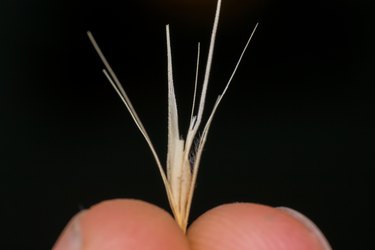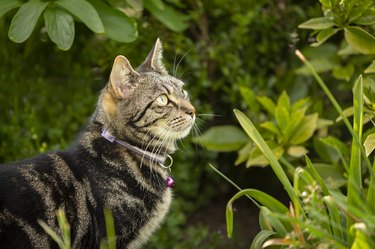Most dog parents have likely heard about the dangers the foxtail plant poses to pups. Since dogs spend so much time outside, they're more likely to encounter foxtails than indoor-only (or mostly-indoor) cats. However, cat parents should be aware that foxtails are equally dangerous to cats. It's important for cat parents to be aware of the signs and know what to do in case of an embedded foxtail.

Video of the Day
What are foxtails?
"Foxtail" refers to the seed-like structures found at the tops of grasses. Foxtails, or grass awns, can be any of the roughly 25 weedy grasses in the Alopecurus or Setaria genera of the Poaceae family. Foxtails are found throughout most of North America. They are most common from late spring to early fall but can exist year-round in California.
Video of the Day
Foxtail seed heads have sharp, pointed tips and are designed to burrow. Once the seed head dries, the seeds are easily dispersed and can become lodged into any part of a cat's body.
The dangers of foxtail season for cats
Unlike some other plants, foxtails do not contain a chemical that is poisonous to cats. The danger lies in the design of the seed itself. Because of its shape, a foxtail seed can only move forward (never backward) once it has become lodged in a cat's body. The seed contains microscopic barbs that can carry bacteria and spread infection as it moves.
Foxtails can enter a cat's body through any opening. This includes the eyes, ears, mouth, nose, and genitals. They can also become embedded in the skin and are commonly found on paws and bellies. Since the seeds are so small, they are often easy to overlook. They can cause huge problems if they become embedded in a pet.

Signs and treatment for an embedded foxtail in a cat
If your cat has outdoor privileges or accidentally darts outside, do a thorough physical check immediately. Foxtails are most commonly found on paw pads, between toes, and on the face and belly. Check these areas and use a fine-toothed comb or brush on their coat. You can remove foxtails that are stuck to the skin (not yet embedded) with your hands or tweezers. Once removed, wash the area gently with antibacterial soap and rinse with clean water. If a foxtail is too deeply embedded to be removed easily with tweezers, take your cat to an animal hospital immediately.
If a cat has inhaled a foxtail seed, it could become lodged in their nasal passage or airway. Symptoms include sneezing, coughing, pawing at the face, or having difficulty breathing. If a foxtail becomes lodged in the ear, it can travel to the ear canal and eardrum. This can cause persistent head-shaking or scratching at the ears in cats. Foxtails embedded in the paws can cause swelling, abscesses, or discharge between the toes. You may see your cat limping or licking their paws excessively.
If an embedded foxtail is not removed, it can cause serious damage to a cat's internal organs. An embedded foxtail will not work its way out of the body — and needs to be treated by a veterinarian. If you discover an embedded foxtail or your cat displays any of the above symptoms, get them to an animal hospital right away. Your veterinarian may give pain medication and antibiotics. Surgery may be necessary depending on your cat's symptoms.

How to prevent foxtails
Even if your cat is indoor-only, check all outdoor areas for foxtails in the event your kitty gets out of your home. Mow your lawn regularly by using an attached lawn bag, so the foxtail seed heads are collected instead of dispersed in the yard. Use gloves to grab the stem and pull out any stray foxtails by the root.
If your cat is allowed outside, check your yard before letting them out. Be sure to check over your cat once they come back in as well. If your cat tends to wander outside of your yard, you may want to consider getting a catio or an outdoor enclosure. Some might think cats need outside time to be happy, but indoor cats can thrive if provided with plenty of enrichment items. This will give them the physical and mental exercise they would get outside - without risking exposure to foxtails and other dangers. You can also hang bird feeders near windows where your cat can watch all the activity.
In summary
Foxtails are dangerous to cats. Foxtail seeds can become embedded in a cat's body and cause serious injury and infection. The best way to prevent foxtail injuries is to keep your cat indoors. Remove foxtails in your yard if you see them, and check your cat all over if he goes outside. If you find or suspect an embedded foxtail, get your cat to an animal hospital right away.